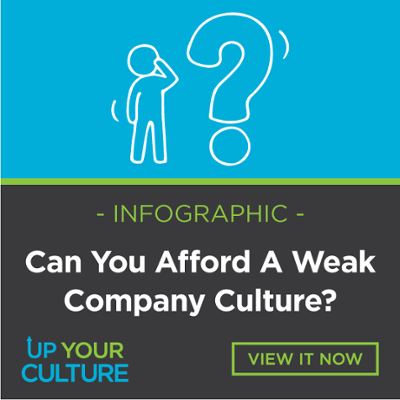
In today’s ultra-competitive environment, company executives have to make choices every day about where to invest time, energy, and money to keep their companies viable and profitable.
Sometimes those choices are obvious like new product development or software systems to allow the organization to run more efficiently and productively. Sometimes, however, the right choices are not so obvious which raises the question, is devoting effort and resources to less tangible projects like a healthy company culture really worth it?
Here are five things to think about when pondering that question.
How Does Company culture affect the bottom line?
 1. Companies with highly-engaged employees grow revenue 2.5 times as much as those who don’t.
1. Companies with highly-engaged employees grow revenue 2.5 times as much as those who don’t.
This company culture statistic came right out of recent study by Culture Amp. So, how is this possible? When your employees are engaged, they're emotionally committed and willing to give their best at work. Engaged employees feel as though they have a stake in the game and a sense of purpose which makes them willing to give it everything they’ve got to achieve success. You can’t demand this type of behavior from your people. You have to earn it.
2. Customer retention for companies with an engaged workforce goes way up.
In fact, the Aberdeen Group found a 233% greater customer loyalty among companies with a healthy culture. When you consider the cost of key customer turnover, that’s big deal. All your efforts in new business development can easily be negated by a leaky bucket among your customer base.
3. The war for good talent is real and engaged employees are 87% less likely to leave your organization if you have a healthy, thriving culture.
That number comes from the Corporate Leadership Council — and it’s huge! Reducing regrettable turnover is a significant cost savings that most companies don’t take into proper consideration.
If the cost of turnover is 1.5 times the annual salary for all jobs, what is the cost of turning over your best people, especially when they go to your competition? Costs related to losing talent on board now and all those related to replacing them is an un-budgeted expense akin to internal bleeding.
When I tell executives they need to budget X number of millions of dollars for the cost of losing people on board now and replacing them, they chuckle. But, they shouldn’t.
4. Speaking of that war for talent, a healthy company culture is a recruitment magnet.
People want to work for the best companies where they can’t wait to start working every day because they love what they do and are part of a culture that supports their efforts and makes them feel included. Again, this is one of things you cannot mandate, only create.
5. A healthy culture allows you to be known as a value-added employer which has a host benefits.
Besides all the aforementioned pluses for productivity there are numerous other outcomes that have bottom-line impact. Your pay scale can be appropriate for your industry where as companies with weak or toxic cultures have to pay a premium to keep their people on board.
Your customers certainly benefit from creative, engaged individuals and teams who solve problems readily and bring them fresh ideas. You will also be building your own internal bench of talent as people engage their talents and reach their full potential. Better they do this for you than someone else.
Improve Your Bottom Line By Growing Your Company Culture
Still have doubts about whether a healthy company culture affects your bottom line?
Start measuring the five areas above and you'll see improvement in these aspects actually make your bottom line. Check Glassdoor.com to see what your current and past employees are saying about working for your company and then begin a process to improve regardless of where you are now.
Companies with weak cultures can improve with the right approach and companies with relatively good cultures are perhaps the most motivated to move to the next level because they know it really does make a measurable difference.








Leave a Comment